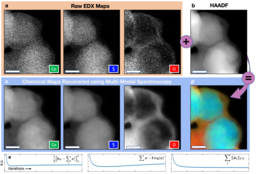Recovering Chemistry from Atomic to Nanometer Resolution using Multi-Modal Spectroscopy
TECHNOLOGY NUMBER: 2021-345

OVERVIEW
Optimization algorithm for multi-modal imaging using HAADF and EDX/EELS measurements- Five times increase in signal-to-noise ratio compared to state-of-the-art electron microscopy
- An approach that can be implemented during signal recovery or even retrospectively
BACKGROUND
In fields such as materials science, medicine, and biology, there is an increasing need for imaging techniques that provide both structural and elemental composition information at nanometer and atomic scales. Advances in scanning transmission electron microscopy (STEM) have enabled such imaging through the simultaneous use of other imaging modalities including energy dispersive X-ray (EDX), electron energy loss spectroscopy (EELS), and high-angle annual dark field (HAADF) techniques. Conventionally, HAADF has been analyzed separately from EDX/EELS.
INNOVATION
University of Michigan researchers have developed a method for multi-modal chemical imaging that dramatically improves image contrast and signal-to-noise (SNR) by five times compared to conventional electron microscopy. The algorithm leverages correlated information encoded within HAADF and EDX/EELS imaging modalities. The approach requires no special equipment and can be implemented during signal collection or retrospectively.
The technology offers several benefits over other multi-modal STEM imaging approaches. Less intense electron beams may be used for sensitive samples. Images from less sophisticated instruments can be enhanced without adding additional expensive detectors. For higher end instruments, the SNR may be sufficient for many samples so as to enable 3D multi-modal imaging.
It is anticipated that this multi-modal chemical imaging will have application in a wide variety of research areas within materials science, medicine, and biology. This technology may be performed by the imaging instrument or remotely (e.g., by a hosted software-as-a-service product) using data collected from standard multi-modal instruments.